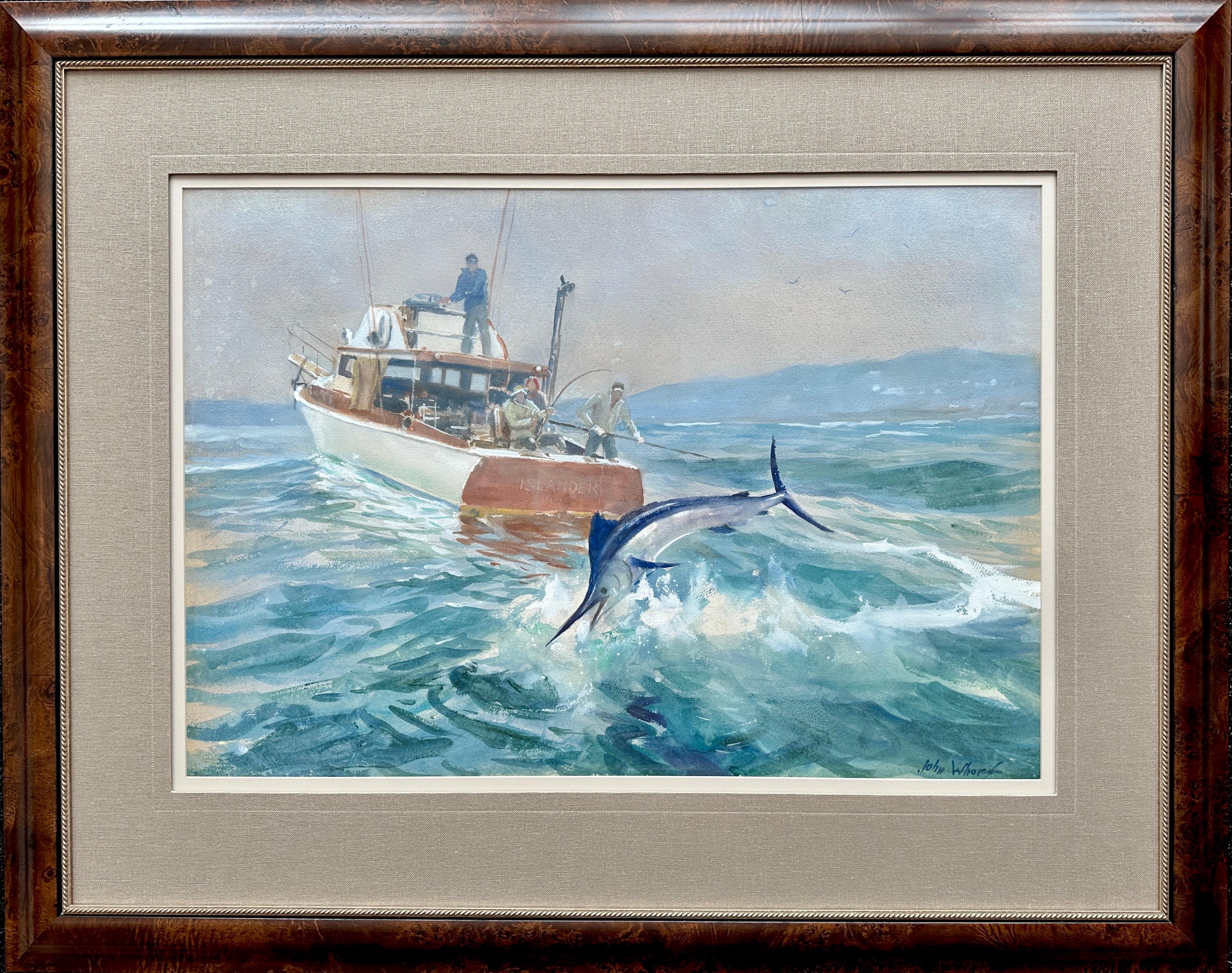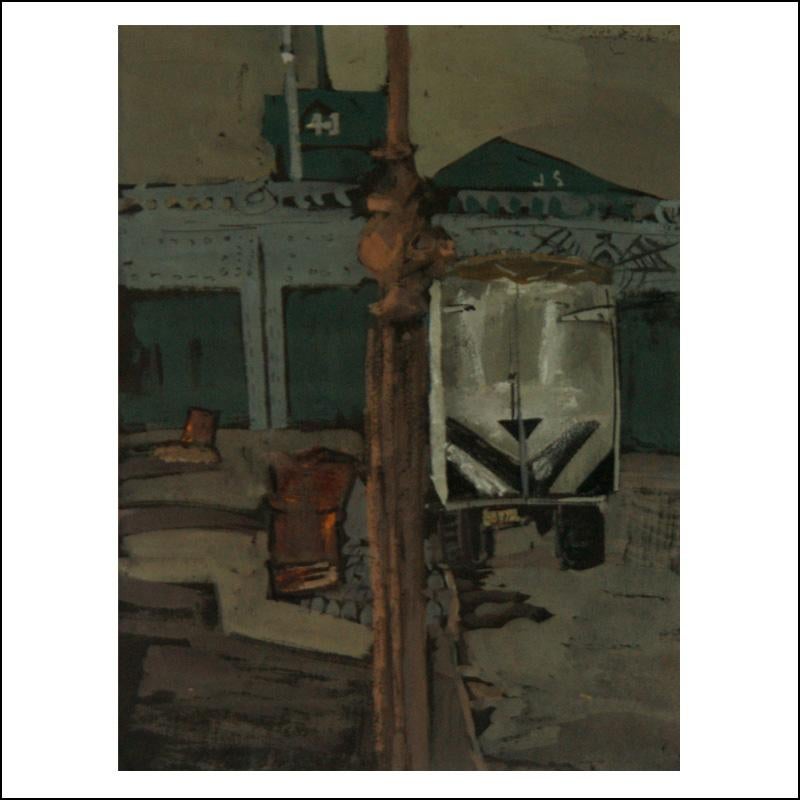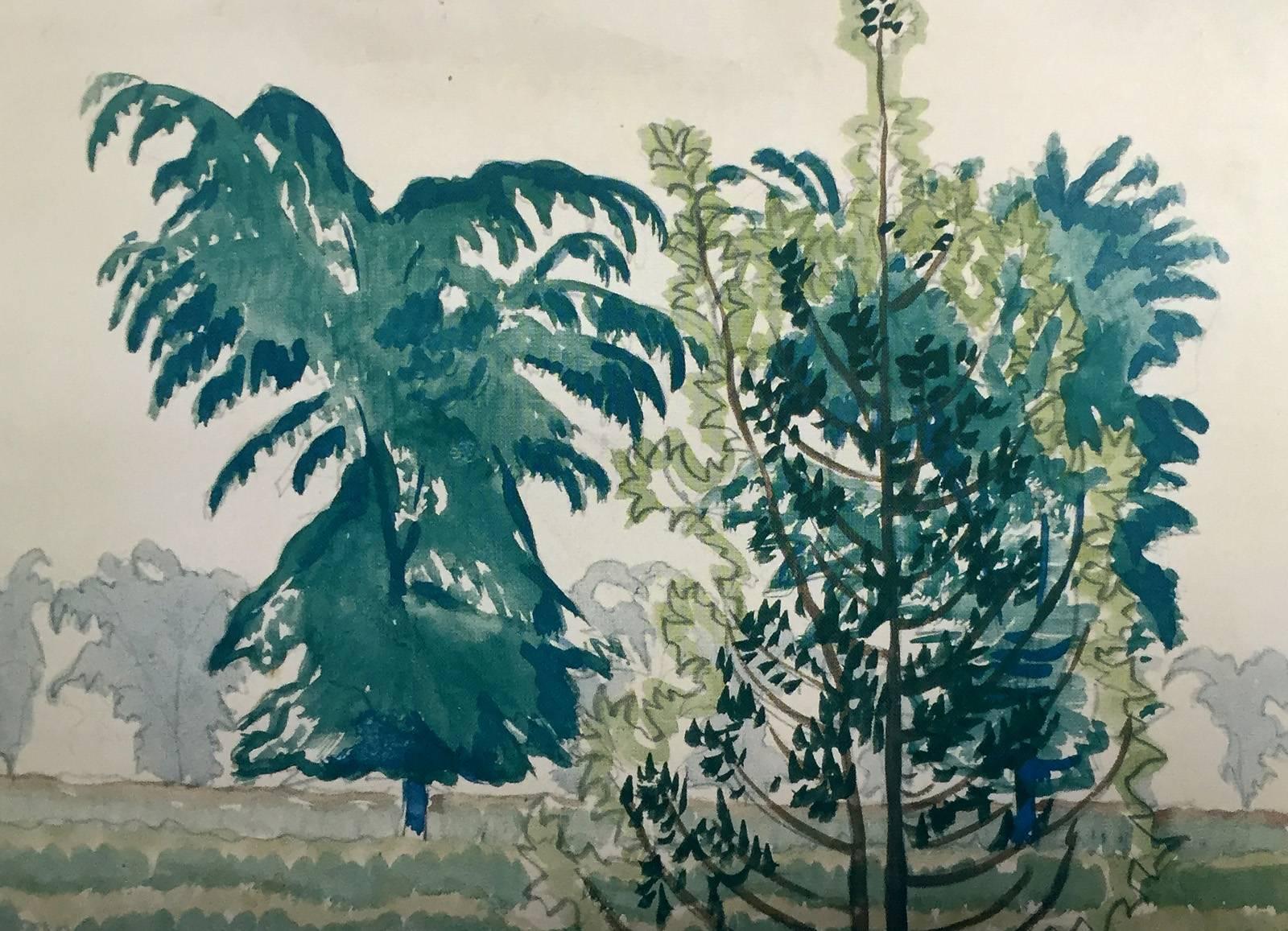Items Similar to Watercolor of Doylestown, PA by Ranulph Bye
Want more images or videos?
Request additional images or videos from the seller
1 of 9
Ranulph ByeWatercolor of Doylestown, PA by Ranulph Bye1958
1958
About the Item
Ranulph Bye (American, 1916-2003)
Rocks and Trees (Doylestown, PA), 1958
Watercolor on paper
14 x 21 in.
Framed: 23 1/8 x 30 1/4 in.
Signed bottom: Ranulph Bye
Ranulph Bye was born in 1916 in Princeton, NJ. He attended the Philadelphia Museum School of Industrial Art, now Philadelphia College of Art, and the Art Students League in New York. His paintings have received national recognition, and he has exhibited in the National Academy of Design, the American Watercolor Society, and Allied Artists.
His work is in the collection of the Boston Museum of Fine Arts, the Moore College of Art, Temple University School of Pharmacy; Munson-Williams- Proctor Institute, Utica, NY; the Reading Museum; the Smithsonian Institution and the William Penn Memorial Museum in Harrisburg. Mr. Bye's work has appeared in American Heritage and American Artist.
He is a member of the Philadelphia Water Color Club, the American Watercolor Society, Allied Artists of America and the National Academy of Design (Academician). Also the Salmagundi Club of New York. His paintings have earned him many prizes. "Painting Buildings in Watercolor" was published by North Light Books in 1994. Other books are "Ranulph Bye's Bucks County" published in 1989 and "Victorian Sketchbook" which is a pictorial journey of Victorian architecture around the country published in 1980. His newest book is "Ranulph Bye's Collection of Old Firehouses".
Now retired from Moore College of Art where he taught for thirty years, Mr. Bye devotes most of his time to painting in and around his native Bucks County, Pennsylvania home.
According to the biography of the artist posted by the Bucks County Museum in Doylestown, Pennsylvania, Ranulph Bye died on November 19, 2003.
He is described as "one of the foremost watercolorists in the country, who since 1953 painted over three-thousand watercolor scenes, mostly rural American landscapes, seascapes, rural America and buildings, especially Victorian style for his book, "Victorian Sketchbook".
A Bucks County regionalist painter tied to the New Hope Colony, Bye was from long-time Pennsylvania family who have held a land grant from William Penn from 1699.
Bio sourced from the Archives of AskArt.
- Creator:Ranulph Bye (1916 - 2003)
- Creation Year:1958
- Dimensions:Height: 23.125 in (58.74 cm)Width: 30.25 in (76.84 cm)Depth: 0.5 in (1.27 cm)
- More Editions & Sizes:Unique 1 of 1Price: $700
- Medium:
- Movement & Style:
- Period:
- Condition:Not examined outside of frame.
- Gallery Location:Larchmont, NY
- Reference Number:1stDibs: LU2211212087202
About the Seller
5.0
Platinum Seller
These expertly vetted sellers are 1stDibs' most experienced sellers and are rated highest by our customers.
1stDibs seller since 2022
37 sales on 1stDibs
Typical response time: <1 hour
- ShippingRetrieving quote...Ships From: Larchmont, NY
- Return PolicyA return for this item may be initiated within 14 days of delivery.
More From This SellerView All
- 4 American Watercolors, c. 1950s, by Mary M. JohnsenLocated in Larchmont, NYMary M. Johnsen Four Paintings, c. 1950s Watercolor Dimensions: 1. Mat: 18 x 21 1/4 in., page: 8 x 12 1/4 in. 2. Page: 14 7/8 x 22 in. 3. Mat: 15 x 19 in., page: 10 1/2 x 14 1/2 in....Category
1950s American Modern Landscape Drawings and Watercolors
MaterialsPaper, Watercolor
- Lovely Impressionist Coastal Scene of New York in PastelLocated in Larchmont, NYUntitled (Coastal New York) Pastel on paper 17 1/2 x 23 1/2 in. Framed: 24 1/2 x 30 in. Signed lower rightCategory
20th Century American Modern Landscape Drawings and Watercolors
MaterialsPaper, Pastel
- Charles Burchfield Preparatory Sketch, Early 20th CenturyBy Charles E. BurchfieldLocated in Larchmont, NYCharles Burchfield (1893-1967) Untitled (Preparatory Drawing for Skyscape), Early 20th Century Pencil on paper 12 1/4 x 18 3/4 in. Inscribed: blue / white / blue / RV Born in Ashtab...Category
Early 20th Century American Modern Landscape Drawings and Watercolors
MaterialsPaper, Pencil
- Beautiful large impressionist pastel by Francesco SpicuzzaBy Francesco SpicuzzaLocated in Larchmont, NYFrancesco Spicuzza (American, 1883-1962) Untitled Landscape, 20th century Pastel on paper Sight size: 24 x 30 in. Framed: 26 1/4 x 32 3/8 in. Signed lower right: Spicuzza Italian-born Francesco Spicuzza was primarily a Wisconsin painter who did portraits, still-lives and local landscapes. He spent the first part of his life in near-poverty to become a painter. An eternal optimist, in 1917, the artist reported: "I am happy and my only ambition now is to paint better and better until I shall have reached the measure of the best of which I am capable." (Spicuzza, 1917, p. 22). His predilection for beach scenes germinated early: reportedly, the five-year-old boy first drew the outlines of his father's fishing boat in the sand on the seashore near their home in Sicily. After setting himself up as a fruit peddler in Milwaukee, Spicuzza's father sent for his family when Francesco was eight years old. For the following six years the boy was unable to attend school because of his job in his father's fruit and vegetable business. The poor lad suffered a caved-in shoulder from carrying a heavy wooden crate. The young Spicuzza was aided by moral and financial support from a sympathetic Milwaukee businessman named John Cramer, publisher and editor of the Evening Wisconsin, who raised Spicuzza's salary as a newspaper assembler so that he could attend school. In 1899 or 1900, Spicuzza began studying drawing and anatomy under Robert Schade (1861-1912), a painter of panoramas who had been trained in Munich under Carl Theodor von Piloty. Spicuzza was also taught by Alexander Mueller (1872-1935), a product of the Weimar and Munich academies. Mueller realized Spicuzza was a colorist and encouraged that orientation (Madle, 1961). Spicuzza found it beneficial to accept an apprenticeship in a lithographic studio for $8 a week, which demanded most of his time. During the St. Louis Universal Exposition in 1904, still a struggling student, Spicuzza attended the fair, thanks to Cramer. It was not long before Spicuzza received a twenty-five dollar portrait commission, and this inaugural success led to new commissions and allowed him to continue as a painter. The earliest influences in his work appear to be from Edward H. Potthast and Maurice Prendergast, though Spicuzza never mentioned either artist. Already in August 1910, Spicuzza was described in a newspaper as "one of the most talented of Milwaukee's rising workers." He undoubtedly received lasting inspiration from his one summer study period in 1911 with John F. Carlson at the Art Students League's Summer School in Woodstock, New York. Certainly Spicuzza would have picked up spontaneity in handling the brush from Carlson. Although he executed numerous still-lives and an occasional religious work, Spicuzza is best known for his Milwaukee beach scenes populated with frolicking bathers in multi-colored attire, not unlike the images of Potthast, who used a similar technique. Many of these are small, preparatory works on canvas board executed between 1910 and 1915. Frequently with even greater animation than Potthast, Spicuzza produced moving images of youthful energy and uninhibited child's play. These beach genre scenes reflect the attitude of American impressionists who depicted the more pleasant side of life. Spicuzza manipulated a successful balance of rich pigment applied in varying degrees of impasto texture with subtle nuances of hue. Working all'aperto, he sought "the soft enticing shades of yellow, blue, green, pink and lavender . . . to get the effects of bright glistening summer air." (L.E.S., n.d.). As a painter whose color not only derived from direct observation but also from a personal theory of color symbolism, Spicuzza traded the linear approach of lithography for dynamic patches of brilliant color. Like Prendergast, he would often tilt the angle of the picture plane to bring the viewer's position above the scene. Spicuzza was unable to enter the 1913 Armory Show or the Panama-Pacific International Exposition two years later but he did submit work to the annual exhibitions of the Pennsylvania Academy of the Fine Arts and those of the Art Institute of Chicago. His first important award was the bronze medal presented by the St. Paul Institute in 1913, which was followed by the silver medal two years later. Before long, Spicuzza had acquired a greater sense of security in his profession and was described by a writer in International Studio (April 1917) as "an independent artist with an assured future. His pastels and water-colours are poetic and joyous bits of nature with a genuine out-of-door feeling." In 1918, his Spirit of Youth, exhibited at the National Academy of Design, sold for $112.50. Four years later, the artist achieved his greatest local recognition by winning the gold medal from the Milwaukee Art Institute. Spicuzza spent a great deal of time painting en plein air and by 1925 he began summering at Big Cedar Lake, near West Bend, Wisconsin to gather his subject matter. Easter Morning (1926) owes something to the Symbolist movement, with its figure of Christ appearing over a seascape. During the difficult era of the Depression, patrons came to Spicuzza's aid and during the 40s, he taught housewives, businessmen and students at the Milwaukee Art Institute, the Milwaukee Art Center, and in his private studio. In the following decade, although his kind of art was no longer popular in the "make-it-or-break-it" New York gallery world, Spicuzza enjoyed regular patronage and sales. His beach scenes became more static and he would experiment with modernist techniques. Spicuzza died at the age of seventy-eight. Sources: L.E.S., "Do Colors Change a Person's disposition? Experiments of a Milwaukee Artist...Category
20th Century American Modern Landscape Drawings and Watercolors
MaterialsPaper, Pastel
- c. 1900 German Watercolor of a Mountainside TrailLocated in Larchmont, NYUntitled (Mountainside Trail), c. 1900 Watercolor on paper 6 1/8 x 7 3/4 in. Mat: 8 x 10 in.Category
Early 1900s Impressionist Landscape Drawings and Watercolors
MaterialsPaper, Watercolor
- Stein am Rhine, 1912 German WatercolorLocated in Larchmont, NYStein am Rhine, 1912 Watercolor on paper 7 x 5 in. Mat: 10 3/4 x 8 3/4 in. Inscribed lower right: Stein a/Rh, Juni 1912 At the point where Lake Constance again becomes the Rhine Riv...Category
1910s Impressionist Landscape Drawings and Watercolors
MaterialsPaper, Watercolor
You May Also Like
- Leaping Marlin (with fisherman on the boat Islander) by John WhorfBy John WhorfLocated in Hudson, NYJohn Whorf captures one of the thrilling moments of fishing in this watercolor – when the fish is on the line, but still trying to escape. One of the fastest fish in the world, marlin fishing...Category
1950s American Modern Animal Drawings and Watercolors
MaterialsWatercolor, Paper
- "Rail Yard" Urban Industrial WPA American Scene Drawing NYC Mid-CenturyBy Joseph SolmanLocated in New York, NY"Rail Yard" Urban Industrial WPA American Scene Drawing NYC Mid-Century. Initialed "JS" upper right Solman was a pivotal figure in the development of 20th century American art. He ...Category
1930s American Modern Landscape Drawings and Watercolors
MaterialsPaper, Gouache
- California Impressionist Landscape Painting Framed 19th Century Rare PurpleLocated in Buffalo, NYAn original American impressionist figurative watercolor of a California coastline with trees.Category
Early 1900s American Modern Landscape Drawings and Watercolors
MaterialsPaper, Watercolor
- Untitled (Trees)By Charles E. BurchfieldLocated in Buffalo, NYAn original watercolor on paper by American modernist Charles E. Burchfield, created in 1916. This work comes in an archival frame presentation and has been authenticated by the Bur...Category
1910s American Modern Landscape Drawings and Watercolors
MaterialsPaper, Watercolor
- "New York City Skyline View from the East River, " Lionel Reiss, Jewish ArtistBy Lionel ReissLocated in New York, NYLionel S. Reiss (1894 - 1988) New York City Skyline View from the East River Watercolor on paper 13 x 19 inches Signed lower left In describing his own style, Lionel Reiss wrote, “By nature, inclination, and training, I have long since recognized the fact that...I belong to the category of those who can only gladly affirm the reality of the world I live in.” Reiss’s subject matter was wide-ranging, including gritty New York scenes, landscapes of bucolic Bucks County, Pennsylvania, and seascapes around Gloucester, Massachusetts. However, it was as a painter of Jewish life—both in Israel and in Europe before World War II—that Reiss excelled. I.B. Singer, the Nobel Prize winner for Literature, noted that Reiss was “essentially an artist of the nineteenth century, and because of this he had the power and the courage to tell visually the story of a people.” Although Reiss was born in Jaroslaw, Poland, his family immigrated to the United States in 1898 when he was four years old. Reiss's family settled on New York City’s Lower East Side and he lived in the city for most of his life. Reiss attended the Art Students League and then worked as a commercial artist for newspapers and publishers. As art director for Metro-Goldwyn-Mayer, he supposedly created the studio’s famous lion logo. After World War I, Reiss became fascinated with Jewish life in the ‘Old World.’ In 1921 he left his advertising work and spent the next ten years traveling in Europe, the Middle East, and North Africa. Like noted Jewish photographers Alter Kacyzne and Roman Vishniac, Reiss depicted Jewish life in Poland prior to World War II. He later wrote, “My trip encompassed three main objectives: to make ethnic studies of Jewish types wherever I traveled; to paint and draw Jewish life, as I saw it and felt it, in all aspects; and to round out my work in Israel.” In Europe, Reiss recorded quotidian scenes in a variety of media and different settings such as Paris, Amsterdam, the Venice ghetto, the Jewish cemetery in Prague, and an array of shops, synagogues, streets, and marketplaces in the Jewish quarters of Warsaw, Lodz, Krakow, Lublin, Vilna, Ternopil, and Kovno. He paid great attention to details of dress, hair, and facial features, and his work became noted for its descriptive quality. A selection of Reiss’s portraits appeared in 1938 in his book My Models Were Jews. In this book, published on the eve of the Holocaust, Reiss argued that there was “no such thing as a ‘Jewish race’.” Instead, he claimed that the Jewish people were a cultural group with a great deal of diversity within and between Jewish communities around the world. Franz Boas...Category
1940s American Modern Landscape Drawings and Watercolors
MaterialsPaper, Watercolor
- "Grain Elevators, Buffalo"By Ralston CrawfordLocated in Lambertville, NJJim’s of Lambertville is proud to offer this artwork by: Tobias Musicant (1921 – 2004) A new discovery in the art world is something always searched for and rarely found. Surely th...Category
1930s American Modern Landscape Drawings and Watercolors
MaterialsWatercolor, Paper, Ink




